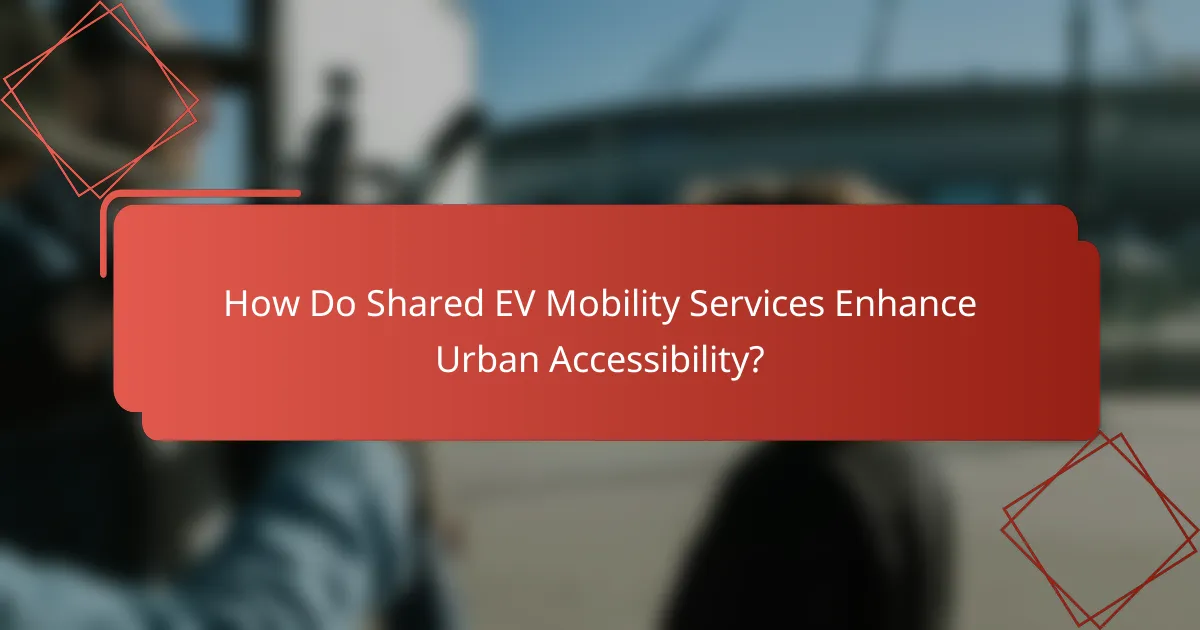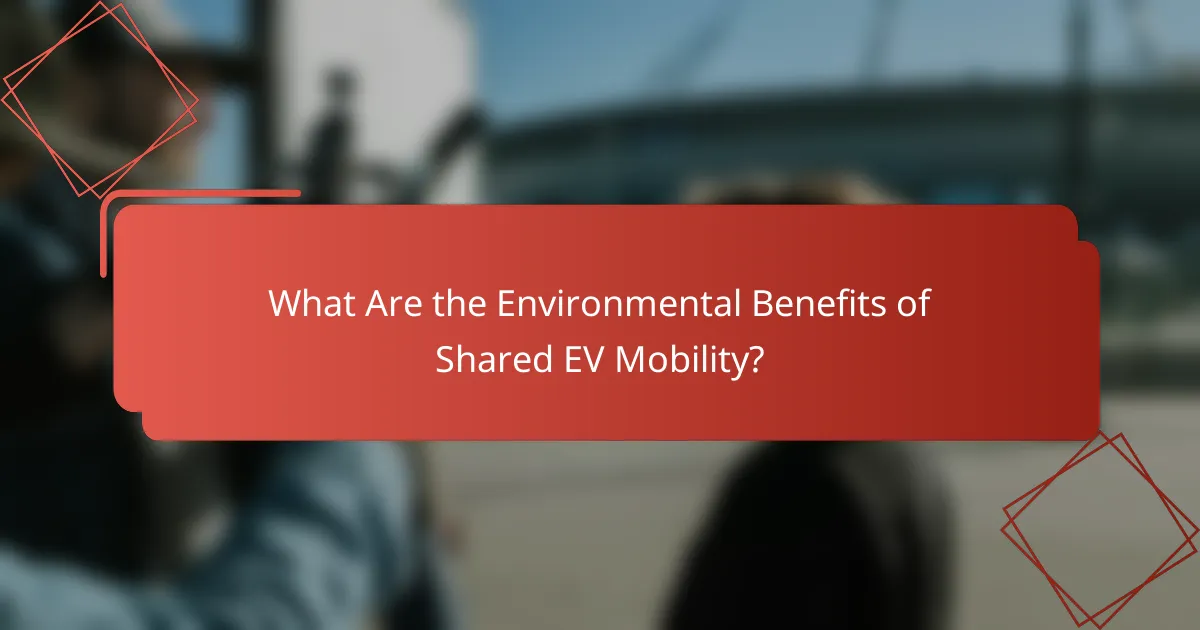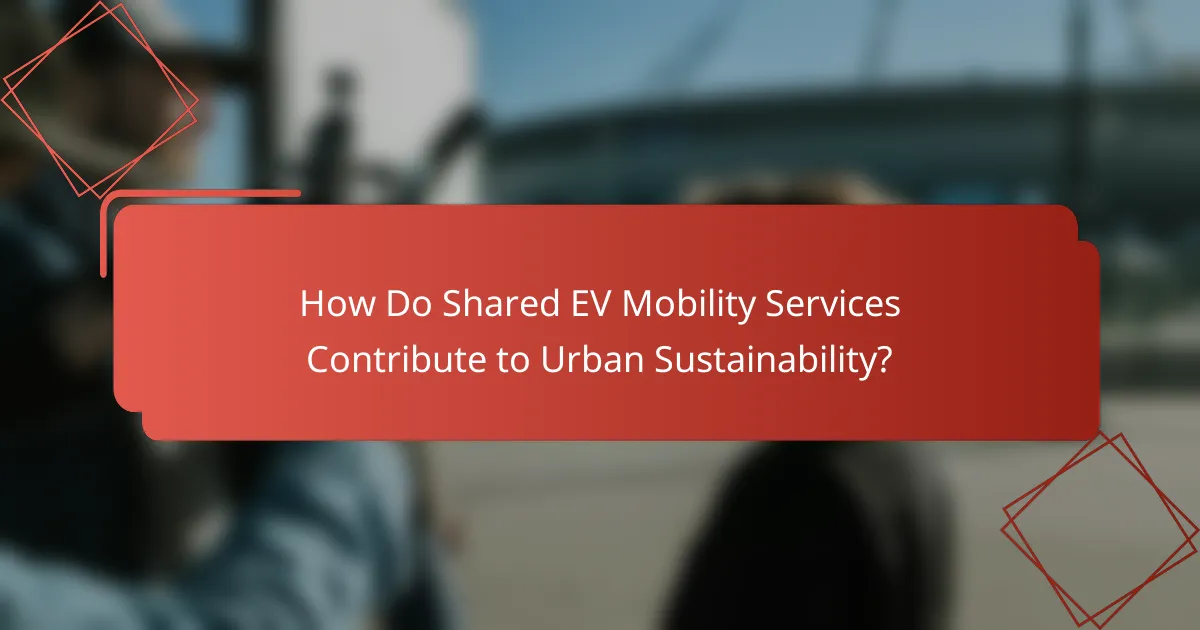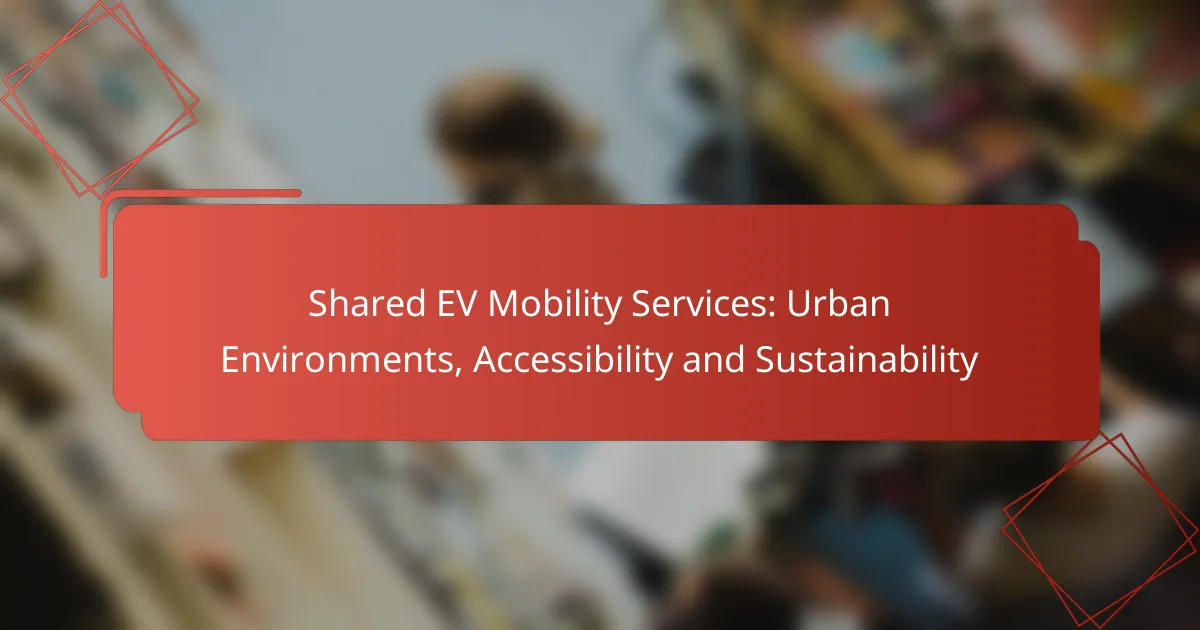Shared electric vehicle (EV) mobility services are transforming urban transportation by enhancing accessibility and promoting sustainability. By offering flexible alternatives to personal vehicles, these services not only reduce traffic congestion but also lower the environmental impact associated with traditional fossil fuel transportation. As cities continue to embrace these innovative solutions, they pave the way for a greener and more accessible urban future.

How Do Shared EV Mobility Services Enhance Urban Accessibility?
Shared electric vehicle (EV) mobility services significantly improve urban accessibility by providing flexible and sustainable transportation options. These services reduce reliance on personal vehicles, making it easier for residents to navigate cities while promoting eco-friendly practices.
Improved public transport integration
Shared EV mobility services can enhance the efficiency of public transport systems by offering seamless connections between various modes of transportation. For instance, users can easily switch from a bus or train to an electric vehicle, reducing waiting times and improving overall travel experience.
Many cities are now implementing integrated payment systems that allow users to pay for both public transport and shared EV services with a single app. This integration encourages more people to utilize public transport, ultimately decreasing traffic congestion and emissions.
Affordable transportation options
Shared EV services provide cost-effective alternatives to traditional taxis and personal vehicle ownership. Users typically pay per trip or through subscription models, which can be more economical, especially for those who do not need a vehicle on a daily basis.
In urban areas, the average cost of using shared EVs can be significantly lower than owning a car when considering expenses such as insurance, maintenance, and parking fees. This affordability makes it accessible for a wider range of income levels, promoting inclusivity in urban mobility.
Last-mile connectivity solutions
Last-mile connectivity is crucial for ensuring that residents can reach their final destinations efficiently. Shared EV services fill this gap by providing quick and convenient rides from public transport hubs to homes or workplaces.
For example, in cities where public transport stops are not within walking distance, shared EVs can bridge the distance, making it easier for commuters to access essential services. This solution is particularly beneficial in areas with limited public transport coverage, enhancing overall urban mobility.

What Are the Environmental Benefits of Shared EV Mobility?
Shared electric vehicle (EV) mobility services significantly reduce the environmental impact of urban transportation. By decreasing reliance on fossil fuels and promoting cleaner alternatives, these services contribute to a more sustainable urban ecosystem.
Reduction in greenhouse gas emissions
Shared EV mobility leads to a notable reduction in greenhouse gas emissions compared to traditional gasoline vehicles. By utilizing electric power, these services can cut emissions by up to 50% or more, depending on the energy source used for charging.
Moreover, the consolidation of trips through shared services minimizes the total number of vehicles on the road, further decreasing overall emissions. This is particularly impactful in densely populated urban areas where traffic congestion is prevalent.
Lower urban air pollution
Electric vehicles produce zero tailpipe emissions, which directly contributes to lower levels of urban air pollution. This is crucial in cities where air quality is often compromised by vehicle emissions, leading to health issues for residents.
Shared EV services can help improve air quality by reducing particulate matter and nitrogen oxides, which are common pollutants from conventional vehicles. As more users opt for shared EVs, cities can experience cleaner air and a healthier environment.
Promotion of renewable energy use
Shared EV mobility services can encourage the use of renewable energy sources for charging, such as solar or wind power. Many EV charging stations are increasingly powered by renewable energy, which enhances the sustainability of the entire transportation system.
By integrating renewable energy into their operations, shared mobility services not only reduce their carbon footprint but also support the broader transition to a sustainable energy grid. This alignment with renewable energy initiatives can further incentivize users to choose electric options over traditional vehicles.

Which Companies Lead in Shared EV Mobility Services?
Several companies are at the forefront of shared electric vehicle (EV) mobility services, each offering unique features and benefits. Key players include Zipcar, Lyft, and Car2Go, which provide flexible transportation options that promote sustainability and accessibility in urban environments.
Zipcar
Zipcar operates a car-sharing service that allows users to rent vehicles by the hour or day, making it ideal for short-term needs. Members can access a variety of electric vehicles, which are strategically located throughout urban areas, enhancing convenience and reducing the need for personal car ownership.
To use Zipcar, individuals must sign up for a membership, which typically involves a registration fee and an hourly or daily rental rate. Users can reserve cars through a mobile app, and the cost often includes insurance and maintenance, making it a straightforward option for urban mobility.
Lyft
Lyft offers a ridesharing service that includes electric vehicles as part of its fleet, promoting eco-friendly transportation. Users can request rides via the Lyft app, which connects them with drivers in their vicinity, allowing for quick and efficient travel within cities.
Lyft’s electric vehicle initiative is part of its broader commitment to sustainability, aiming to reduce carbon emissions. Users should consider the availability of EVs in their area, as this can vary based on location and demand. Additionally, Lyft often provides incentives for drivers to use electric vehicles, enhancing the overall sustainability of the service.
Car2Go
Car2Go, now known as SHARE NOW, provides a flexible car-sharing service that allows users to pick up and drop off vehicles anywhere within a designated area. This service includes a fleet of electric cars, catering to environmentally conscious users who prefer not to own a vehicle.
To access Car2Go, users must download the app, create an account, and find available vehicles nearby. Pricing is typically based on a per-minute rate, which includes insurance and fuel. This model is particularly beneficial for short trips and spontaneous travel, making it a popular choice in urban settings.

What Are the Key Features of Effective Shared EV Mobility Services?
Effective shared EV mobility services prioritize user experience, flexibility, and real-time information. These features enhance accessibility and sustainability in urban environments, making electric vehicle sharing a practical choice for many users.
User-friendly mobile applications
User-friendly mobile applications are essential for effective shared EV mobility services. These apps should offer intuitive navigation, allowing users to easily locate, reserve, and unlock vehicles. Features like clear maps, simple interfaces, and easy payment options enhance the overall user experience.
Additionally, integrating customer support within the app can help users quickly resolve issues or answer questions. This accessibility fosters user confidence and encourages more people to utilize shared EV services.
Flexible subscription models
Flexible subscription models cater to diverse user needs by offering various plans, such as pay-as-you-go, monthly subscriptions, or even long-term rentals. This variety allows users to choose options that best fit their travel patterns and budget, promoting wider adoption of shared EV services.
Some services may offer discounts for frequent users or corporate partnerships, making it financially attractive for businesses and individuals alike. Clear communication of pricing structures helps users make informed decisions.
Real-time vehicle availability tracking
Real-time vehicle availability tracking is crucial for effective shared EV mobility services. Users benefit from knowing the exact location and status of vehicles, which reduces wait times and enhances convenience. Apps should provide live updates on vehicle availability and estimated arrival times.
Incorporating features like notifications for nearby vehicle availability can further improve user engagement. This transparency encourages users to rely on shared EV services for their transportation needs, contributing to a more sustainable urban mobility ecosystem.

How Do Shared EV Mobility Services Contribute to Urban Sustainability?
Shared electric vehicle (EV) mobility services play a crucial role in enhancing urban sustainability by promoting cleaner transportation options and reducing the environmental impact of urban travel. These services help cities transition to greener alternatives, supporting efforts to lower carbon emissions and improve air quality.
Encouragement of electric vehicle adoption
Shared EV mobility services significantly boost electric vehicle adoption by providing users with convenient access to electric cars without the need for ownership. This model allows individuals to experience the benefits of EVs, such as lower operating costs and reduced emissions, which can encourage them to consider purchasing electric vehicles in the future.
Moreover, many cities offer incentives for using shared EV services, including reduced parking fees or access to dedicated lanes. These incentives make electric vehicles more attractive, further driving adoption rates among urban residents.
Reduction of traffic congestion
Shared EV mobility services contribute to the reduction of traffic congestion by decreasing the number of individual vehicles on the road. By providing an alternative to personal car ownership, these services can lead to fewer cars being used for short trips, which are often a major contributor to urban traffic jams.
Additionally, shared EVs can optimize routes and reduce idle time through smart technology, allowing for more efficient use of road space. Cities implementing these services often see a noticeable decrease in congestion, especially during peak hours, leading to smoother traffic flow and improved overall mobility.
